Happy and Sweet: Have the Best 4th of July Ever, From Cakespy
 Thursday, July 3, 2008
Thursday, July 3, 2008 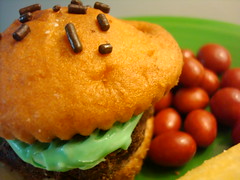
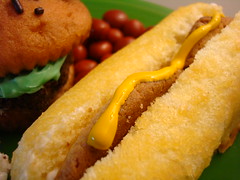
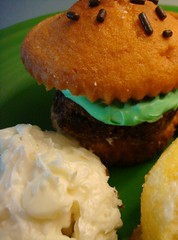
 cakespy mischief,
cakespy mischief,  holidays
holidays 







 Thursday, July 3, 2008
Thursday, July 3, 2008 


 cakespy mischief,
cakespy mischief,  holidays
holidays  Thursday, June 26, 2008
Thursday, June 26, 2008 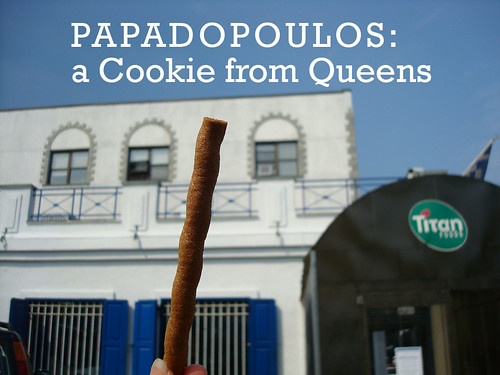
In a faraway place called Greece, there grows a unique and magical tree which yields not lemons, not olives...but cookies. Gorgeous cookies which are straw-like in appearance, and comprised of thin wafer curled around layers of rich creamy filling. They call these the Caprice cookie.
 James Papadopoulos: It's humbling, really. When I walk down the street people sometimes stare, but they're always too shy to say anything. I can see it in their eyes, though -- they know.
James Papadopoulos: It's humbling, really. When I walk down the street people sometimes stare, but they're always too shy to say anything. I can see it in their eyes, though -- they know.
CS: Can you describe what a Papadopoulos cookie is, exactly?
JP: A Papadopoulos cookie is many things (technically when I say "Papadopoulos Cookie" i mean a "Caprice" cookie, Hazelnut or Praline, made by the Papadopoulos cookie company...) but most specifically, it's one of the most delicious, delicate, and memorable cookies I've ever eaten.... seriously. I have different ways of eating them depending on my moods. Usually, I'll take it in my mouth like a cigar, start chewing and feeding it into my mouth until I've got the whole thing eaten in one fell swoop.
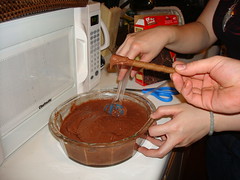 CS: Can you tell us your first Papadopoulos cookie memory?
CS: Can you tell us your first Papadopoulos cookie memory?
JP: I think it was when I was around 4 years old, I had eaten the last of the cookies on a hot summer day, and the filling had melted down onto the corrugated paper liner at the bottom of the tin. I realized that there was enough there to equal almost another cookie's worth of filling. It was a happy time, and I ended up covered in chocolate.
CS: What is the largest quantity of Papadopoulos cookies you've ever consumed in one sitting?
JP: I refuse to answer this question. I don't have a problem. You don't know me!!!!!
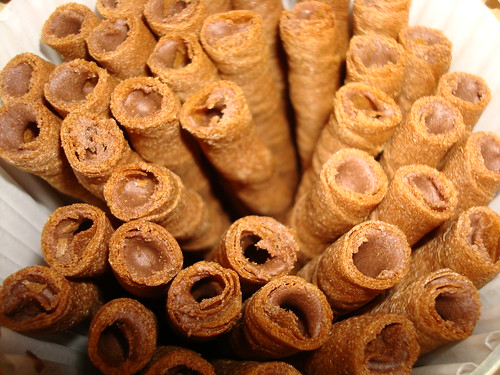 CS: Can people who are not of Greek descent really enjoy a Papadopoulos cookie in the same way you can?
CS: Can people who are not of Greek descent really enjoy a Papadopoulos cookie in the same way you can?
JP: Honestly, I don't think we'll ever know. It all goes back to that existentialist question of "are the colors I see the same as the colors you see?". But to answer your question, no.
CS: You cite Hazelnut as being the finest Papadopoulos cookie flavor. What makes it so superior to, say, chocolate or praline?
JP: Well hazelnut and praline are the filling in the chocolate wafer tube. The hazelnut has a much better flavor, in my opinion, to the others. That brings us to the next question though...
CS: Papadopoulos cookies kind of resemble Pirouline cookies. How do they stack up for you, as a Papadopoulos?
JP: Pirouline and other "wannabe" Papadopoulos cookies pale in comparison. They may LOOK the same, but the amount of creme inside, the crumbly texture of the outer cookie shell, the construction, and overall taste of a Papadopoulos cookie is light-years ahead of anything you'll ever come across.
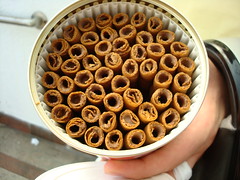 CS: Any final words to add on the joy and beauty of the Papadopoulos cookie?
CS: Any final words to add on the joy and beauty of the Papadopoulos cookie?
JP: Yeah, I just finished the last one in the tin we bought during our adventure in Queens (seriously.. just now, not kidding). When do we get more?
 Sunday, June 8, 2008
Sunday, June 8, 2008 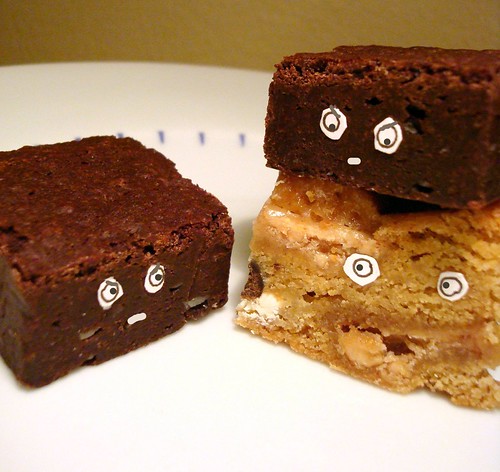
When we recently polled Cakespy readers on which iconic bar they preferred, the blondie or the brownie, we found the results staggering: out of our respondents, 174 vs 49 preferred the brownie.
Now, we understand why brownies ought to be loved. They're soft. They're gooey. They take to a variety of fillings. But are they really so superior to the blondie? Surely, we figure, once people get to know the honey-hued confection they'll show a little more love--so, we took some time to get to know the blondie better, and share it here, so that our readers can see that while it may not be the same as a brownie, it sure ought to be loved:
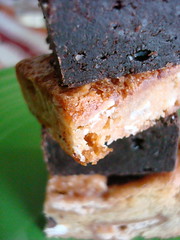 But first things first. What is a blondie? Generally, a blondie is accepted as a type of brownie--but not so much a brownie flavor, more like an identical cousin. An identical, albino cousin. Generally, it uses vanilla or butterscotch base instead of chocolate, and thus has a lighter hue which gives it its name. In our opinion, the finest blondies will have a texture (though not taste) halfway between a cakey and a fudgy brownie: that is to say, delightfully chewy, rich, and dense.
But first things first. What is a blondie? Generally, a blondie is accepted as a type of brownie--but not so much a brownie flavor, more like an identical cousin. An identical, albino cousin. Generally, it uses vanilla or butterscotch base instead of chocolate, and thus has a lighter hue which gives it its name. In our opinion, the finest blondies will have a texture (though not taste) halfway between a cakey and a fudgy brownie: that is to say, delightfully chewy, rich, and dense.
But whatever you may call a blondie, don't call it a brownie wannabe. For as we discovered on foodtimeline.org:
According to old cookbooks, blonde brownies (also known as "Blondies") predated chocolate brownies, though under different names. The primary ingredients of blondies (brown sugar/molasses and butter) compose butterscotch, a candy that was popular in America in the mid-19th century. Some 19th century American cookbooks contain recipes that combined traditional butterscotch ingredients with flour and a leavening agent (baking powder or soda). Presumably, these recipes would have produced something similar to the blonde brownies we enjoy today.
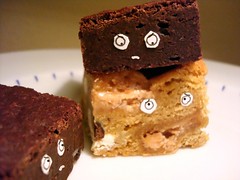 Furthermore, aforementioned recipes are thought to be descendants of gingerbread cakes which dated back to Renaissance times, which eventually evolved to cakes which were baked in shallow pans and included nuts and brown sugar.
Furthermore, aforementioned recipes are thought to be descendants of gingerbread cakes which dated back to Renaissance times, which eventually evolved to cakes which were baked in shallow pans and included nuts and brown sugar.By the 1950s, butterscotch or vanilla brownies were described as "blonde brownies," underscoring the primacy of chocolate.Aren't you starting to feel a little bit for the dear blondie now?
Blondies, the taste of chocolate chips in: Because of the lack of chocolate in the base, it is our opinion that the addition of chocolate chips is better appreciated in the blondie--while we certainly wouldn't say they detract from a brownie's taste (oh, not at all), the contrasting flavor that they add to the blondie's mellow butterscotch taste is beyond compare, each little chocolatey morsel a pleasant surprise and miniature treasure for the tastebuds.
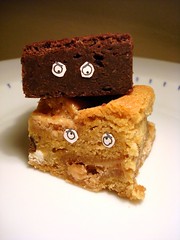 Blondies, lack of frosting atop: With brownies, it seems as though there are two primary types--dense, fudgy, moist brownies, which usually remain unfrosted--and more cakey, slightly fluffier versions, which sometimes have frosting. As much as we love frosting, we have to admit that some frosted brownies make us just a little bit suspicious--like they've got something to hide perhaps? However, we have never before seen a frosted blondie. Naturally, the only conclusion to be drawn is that our dear blondies have nothing to hide. (Cakespy Note: Naturally, when we make some bold statement soon about how everything benefits from the addition of frosting, we expect to be called hypocrites).
Blondies, lack of frosting atop: With brownies, it seems as though there are two primary types--dense, fudgy, moist brownies, which usually remain unfrosted--and more cakey, slightly fluffier versions, which sometimes have frosting. As much as we love frosting, we have to admit that some frosted brownies make us just a little bit suspicious--like they've got something to hide perhaps? However, we have never before seen a frosted blondie. Naturally, the only conclusion to be drawn is that our dear blondies have nothing to hide. (Cakespy Note: Naturally, when we make some bold statement soon about how everything benefits from the addition of frosting, we expect to be called hypocrites).
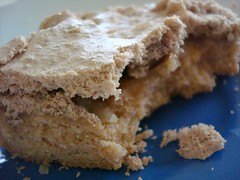 If it sounds good to you to have blondies that are "denser than chocolate chip cookies, more complex than brownies and in the classic Minimalist style" that you can "customize anywhere from a cranberry almond coconut bar to...gunky atery-cloggers"...then it sounds like you'd better check out this one by Smitten Kitchen.
If it sounds good to you to have blondies that are "denser than chocolate chip cookies, more complex than brownies and in the classic Minimalist style" that you can "customize anywhere from a cranberry almond coconut bar to...gunky atery-cloggers"...then it sounds like you'd better check out this one by Smitten Kitchen.
 brownies,
brownies,  cake history,
cake history,  cakespy mischief
cakespy mischief  Sunday, June 1, 2008
Sunday, June 1, 2008
'Nothing,' he said, explaining that when it comes to breakfast, Americans have a Puritanical inhibition. 'Muffins are just an excuse to eat cake for breakfast'
And as a bit of curiosity: We also noticed that there's a difference between the words when used in slang. While both words are used as a term of affection (say, to refer to a child or loved one), "muffin" also has a negative connotation--the term "muffin top" rather indelicately refers to "the phenomenon of overhanging flesh when it spills over the waistline of trousers or skirt in a manner that resembles the top of a muffin spilling over its paper casing." Owch.
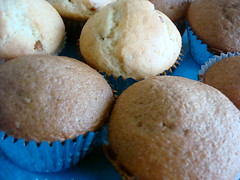
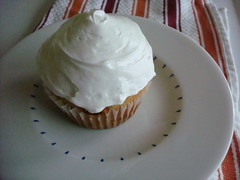
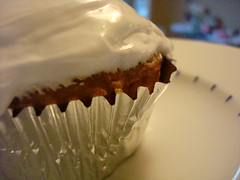
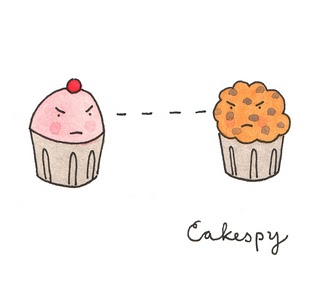
 cakespy mischief,
cakespy mischief,  faceoff
faceoff  Tuesday, May 6, 2008
Tuesday, May 6, 2008 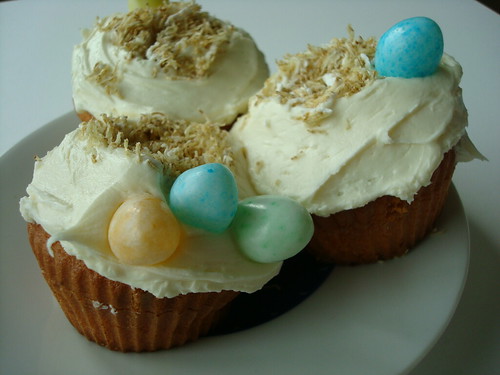
Before anything else, we're going to admit that at Cakespy, we're all total brats about Mother's Day. While we like the idea of celebrating dear mom, something about the whole Laura-Ashley-and-tea-party image of the holiday just doesn't sit right with us. Because really, doesn't that make grand assumptions about mom--that she's a meek little lady who just wants some tea and lace? What about those overbearing, in your face, powerhouse moms? The controlling, sometimes calculating ones, who call you four times a day? Certainly something else is in order for those moms.
And so, it's these moms that we choose to celebrate this Mother's Day: following are just a few ideas about how to mom how you really feel about her this year, with some subliminal messages that are sweet nonetheless:
Made for the mom who just can't let go, how about Empty Nester Cupcakes? These cupcakes have a mini "nest" --we made ours out of crumbled up Shredded Mini Wheats-- with "eggs" -- ours are jelly beans--sitting just outside. Why outside? Well, sometimes it's just time to move on. Mom still having trouble with you having, you know, your own life? Well, this is the perfect way to say "hey mom, I'm gone and I'm never comin' back!".
Idea 2: (s)Mother's Day Cake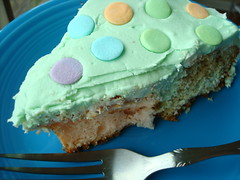
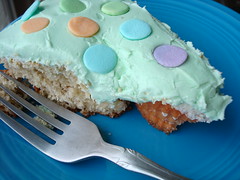
This one's perfect for the overbearing mom who clearly just wants to take credit for everything you do, or who likes to suck the joy out of your achievements. Stage moms, soccer moms, moms who steal your boyfriend--we think you know what we mean. This cake actually has a cupcake buried within, so that the bigger layer cake completely obliterates the cupcake. However, once it's cut into, there's your subliminal message: "Hey ma, you've officially smothered me! Thanks a lot!". A bit heady, sure, but you like feeling smart and in the know, don't you?
How we did it: Make a cake (any type you choose, really); if it is a shallow pan, make it a two layer cake so that its height matches that of a frosted cupcake (in fact, you can use the leftover batter, if any, to make the cupcakes--that's what we did). Once the cake has cooled, if two layers, attach them with a dollop of frosting, but do not frost the top. Scoop out a ball from the center, and insert the frosted cupcake; the height should be slightly lower or even with the height of the cake. Frost just as you regularly would, making sure to cover the cupcake so that the frosting doesn't betray the secret within. Garnish to cover up any imperfections. Serve, and enjoy the confused faces as you get a massive amount of joy at your naughty little secret.
Idea 3: No Cake

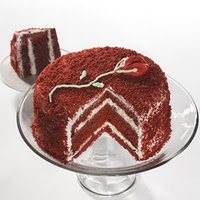 Zabar's is offering a 7" Mother's Day Red Velvet Rose Cake, which is topped with cream cheese icing and filling surrounded with red cake crumbs and a cute little red rose topper. And, they'll ship it anywhere in the US--it Requires 2-day shipping, but wouldn't most things at this point, procrastinator? Available at zabar.com.
Zabar's is offering a 7" Mother's Day Red Velvet Rose Cake, which is topped with cream cheese icing and filling surrounded with red cake crumbs and a cute little red rose topper. And, they'll ship it anywhere in the US--it Requires 2-day shipping, but wouldn't most things at this point, procrastinator? Available at zabar.com.
Dangerous Pies, whose wares we drooled about on Bmoresweet, is now shipping pies within the US--depending on which side you're on in the pie vs. cake revolution, this might be a nice choice for mom. Our vote goes for the Custard Pie--the owner refers to it as a "White Trash Crème Brûlée "--a midwestern comfort food on crack, if you will? We like the thought of that.
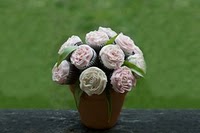 Of course, if you're in the DC area, you may be intrigued by the prospect of these "buttercream blossoms" we read about on DailyCandy--Maryland-based Couture Cupcakes is offering cupcakes formed into little "bouquets"--cute as anything, and far sweeter than flowers, in our opinion. Find them at 301-926-7333 or couture-cupcakes.com.
Of course, if you're in the DC area, you may be intrigued by the prospect of these "buttercream blossoms" we read about on DailyCandy--Maryland-based Couture Cupcakes is offering cupcakes formed into little "bouquets"--cute as anything, and far sweeter than flowers, in our opinion. Find them at 301-926-7333 or couture-cupcakes.com.
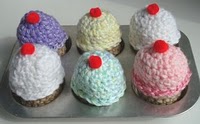

 cakespy mischief,
cakespy mischief,  holidays
holidays  Thursday, May 1, 2008
Thursday, May 1, 2008
 cakespy mischief,
cakespy mischief,  guilty pleasures
guilty pleasures  Sunday, April 27, 2008
Sunday, April 27, 2008 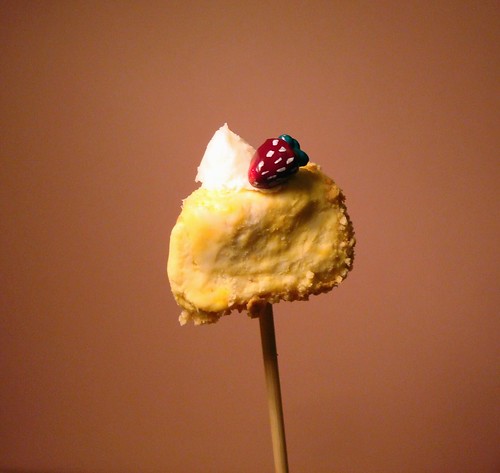
It's that time of month again--that magical moment before rent is due, and when it's time for a Daring Bakers Challenge, a monthly online baking event. The Cakespy crew always awaits this moment with bated breath: it's always such a fun opportunity to misbehave. This month, the challenge was Cheesecake Pops, a recipe chosen by Elle and Deborah, from the aptly titled Sticky, Chewy, Messy, Gooey by Jill O'Connor. What could be cuter (or more decadent) than bite sized cheesecakes, dipped in chocolate and served on a stick? How 'bout mini cheesecakes shaped like slices of "big" cheesecake? See above for our offering. While we offer our apologies for the lack of chocolate dipping, we believe we've more than made up for this omission through cuteness--it has a mini graham cracker crust! And a dollop of faux-whipped cream (made of a daub of cake frosting)! And even a mini marzipan strawberry with glaze!
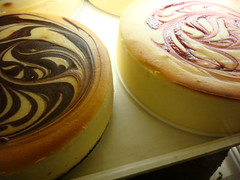 Q: Can I use any type of cheese in cheesecake?
Q: Can I use any type of cheese in cheesecake?
 Q: I have a problem really like wine. Any suggestions for pairing wine with cheesecake?
Q: I have a problem really like wine. Any suggestions for pairing wine with cheesecake?
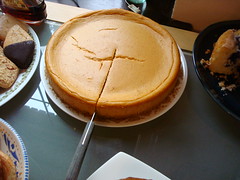 Q: My cheesecake cracked on top! Do I have to throw it away?
Q: My cheesecake cracked on top! Do I have to throw it away?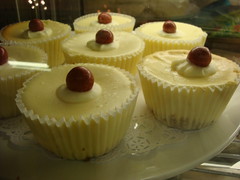 Q: Will cheesecake make me fat?
Q: Will cheesecake make me fat?
*In moderation. As an example of how not to eat cheesecake, consider the example of professional eater Sonya Thomas, who holds the World Record for cheesecake eating, having put away 11 pounds of cheesecake in a mere 9 minutes.
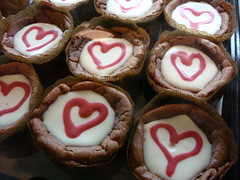 Q: I'm lactose intolerant / vegan / or otherwise can't or won't eat dairy. Whaddya have to say about that?
Q: I'm lactose intolerant / vegan / or otherwise can't or won't eat dairy. Whaddya have to say about that?
A: Go soy! Soft tofu varieties and Tofu cream chees, combined with soy milk or creamer, yield a silky-smooth and absolutely decadent result; even nonvegans may find they don't miss the dairy! This one looks pretty awesome to us.
Q: I like cheesecake so much better the day after it's made! Is there something wrong with me?
A: On the contrary. Cheesecake flavors do tend to develop after baking, making the smooth, creamy cheese blossom on the taste buds once the flavors have had some time to set (though truly, we suspect fairies or elves might play a part too). Our serving suggestion? Make your cheesecake, keep it in the fridge overnight, then leave it at room temperature for an hour or two before serving. Sublime.
 Q: I just did a Google search on Cheesecake and came up with pictures of scantily clad girls. What gives?
Q: I just did a Google search on Cheesecake and came up with pictures of scantily clad girls. What gives?
A: We see you've stumbled upon a classic pinup genre of photography. Here's the story: The "Cheesecake Pose" is said to have gotten its name in 1915 when a newspaper photographer named George Miller noticed a visiting Russian diva, Elvira Amazar, just as she was debarking her ship in New York. Miller asked the opera singer to hike up her skirt a little for the sake of the picture. Later, the photographer's editor, something of a gourmet, is supposed to have exclaimed, "Why, this is better than cheesecake!". So there you go.
 cakespy mischief,
cakespy mischief,  cheesecake
cheesecake  Sunday, April 20, 2008
Sunday, April 20, 2008 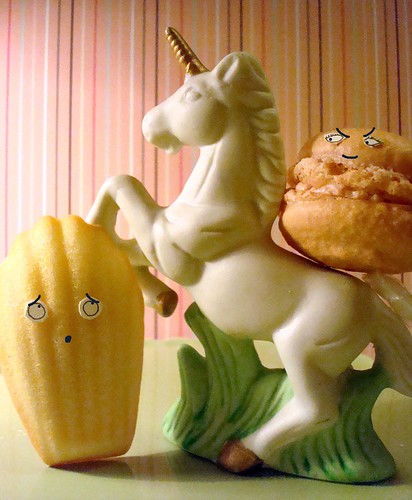
Over the past week, we asked you, our readers, which fancy French cookie you preferred: the macaron or the madeleine. Both cookies are steeped in tradition and lore--while the macaron has a place amongst royalty and in fancy tea salons, the madeleine was immortalized by Proust and also has its own rich history. At the end of our poll, the vote, while certainly not a landslide--was decidedly in the macaron's favor: 169 vs. 123 out of 292 votes.
But what did all of it mean? Like the spies we are, we delved on both sides of the ring to find out more:
 For Veron, who runs the macaron-and-cupcake-makin' business Petites Bouchées (best business ever?), it's the variety and possibility that appeals: "With macarons, the flavors , color and uses are endless - your limit is your imagination. You can just sandwich them simply or make them part of an elaborate dessert. As she goes on to say, while perhaps an acquired taste, they do ultimately hook you: "When I first brought macarons in [to work], it took a while before the container became empty maybe because a lot of people are not familiar with them. Nowadays, on my way to the breakroom to leave some macarons I get stopped on the way so they can have first dibs."
For Veron, who runs the macaron-and-cupcake-makin' business Petites Bouchées (best business ever?), it's the variety and possibility that appeals: "With macarons, the flavors , color and uses are endless - your limit is your imagination. You can just sandwich them simply or make them part of an elaborate dessert. As she goes on to say, while perhaps an acquired taste, they do ultimately hook you: "When I first brought macarons in [to work], it took a while before the container became empty maybe because a lot of people are not familiar with them. Nowadays, on my way to the breakroom to leave some macarons I get stopped on the way so they can have first dibs."
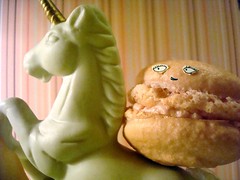
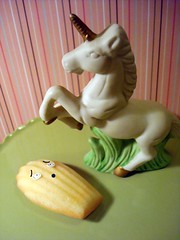
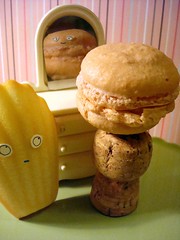
 Cookies,
Cookies,  cakespy mischief
cakespy mischief  Sunday, April 13, 2008
Sunday, April 13, 2008 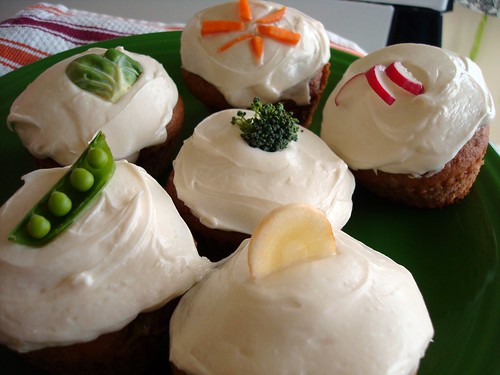
Lately, we've been thinking about carrot cake. Really, when you think about it, it's a bit of a strange beast: a culinary crossroads where cake meets vegetable and yields a beautiful result. How did that combination come about, we wondered? Well, turns out carrot cake (along with other veggie-rich baked goods like zucchini and squash breads) came into popularity during World War II, when butter, eggs and sugar were in short demand. During this time, many baked were made using oil instead of butter, which yielded a dense, pound-cake like texture--and vegetables gained popularity because the water they release during baking yields a tender crumb, and they added a bit of natural sweetness.
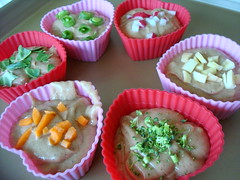
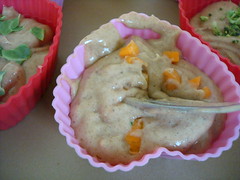
How'd we do it? We took this basic carrot cake recipe (we left out the nuts) and separated it into small batches, subbing different veggies for the carrots into the cake batter and mixing them into individual cupcakes (we did make one carrot cupcake--you know, as consolation if none of them tasted good). All of the creations were topped with cream cheese frosting, and for added cuteness and discernibility, each one was crowned with a veggie garnish.
As for how it all tasted...

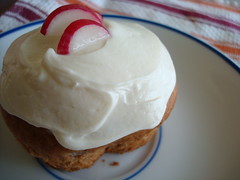
Radish Cake: This one was a pleasant surprise; it had savory, spicy flavor that crept up on the palate, ultimately blossoming into a complex, unusual flavor--one that perhaps might not be for everyone, but it certainly kept us coming back for more. Overall though, if served this cake not knowing it was radish, we might not have been able to identify the flavor.
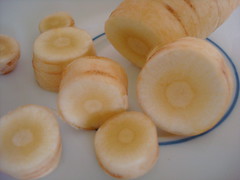
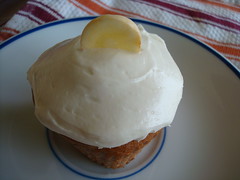
Parsnip Cake: Once baked, the taste of this one was so similar to that of carrot cake that if it were a blind tasting, we'll admit we might have been fooled. In fact, it was only the aftertaste, slightly spicy, which gave away the vegetable's identity as the carrot's albino cousin. If you've got extra parsnips (not sure how often that happens), give it a try!

 cakespy mischief,
cakespy mischief,  cupcakes,
cupcakes,  experiments
experiments  Sunday, March 30, 2008
Sunday, March 30, 2008 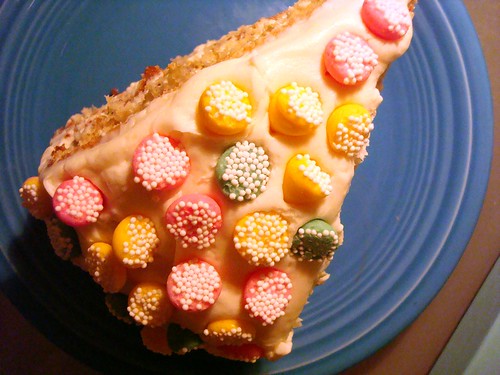
In case you didn't know it, the Cakespy team is part of a group called the Daring Bakers. Each month, a challenge is posted for members, and each member posts their results on the same day on their websites. This month, we were encountered by a challenge that was tres exciting to us: the Perfect Party Cake by Dorie Greenspan. But--and here's a moment of honesty--when we started looking through the recipe, it seemed awfully...involved. (Of course, at Cakespy, as much as we admire fine baking, we are the first to call ourselves expert tasters, novice bakers). And so, making like Shary Bobbins in the Simpsons, we decided to see how much we could get away with by "cutting every corner". But truly, this was an experiment of curiosity rather than pure brattiness. Though we suspected that our end result would be less than bakery-caliber, we wanted to know--would it be completely inedible? Or would it be, you know, kind of ok? Here's how it went.
 For Finishing (we left this out--just frosted it, plain and simple)
For Finishing (we left this out--just frosted it, plain and simple)
Getting Ready
Centre a rack in the oven and preheat the oven to 350 degrees F. Butter two 9 x 2 inch round cake pans and line the bottom of each pan with a round of buttered parchment or wax paper. Put the pans on a baking sheet. (We didn't have parchment or waxed paper so we just buttered those babies and hoped for the best.)
To Make the Cake
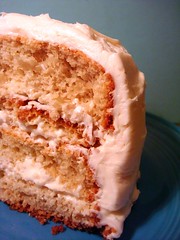

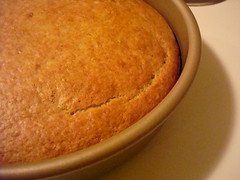

 cake,
cake,  cakespy mischief,
cakespy mischief,  daring baker,
daring baker,  recipes
recipes